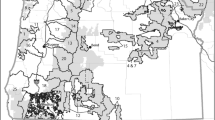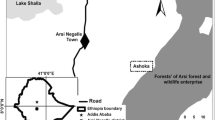Abstract
Collaboration has taken root in national forest planning, providing expanded opportunities for stakeholder participation in decision-making, but are these processes considered meaningful by key stakeholders? Do the processes result in increased participation by key stakeholders? We present results of a study of stakeholder perspectives of a collaborative planning process on the Grand Mesa, Uncompahgre, and Gunnison National Forests in Western Colorado, U.S.A. The stakeholders were stratified by participation levels in order to explore a possible relationship between participation and perceptions of the collaborative process. We used a Q-methodology approach to compare and contrast perspectives across participant levels in the North Fork Valley Landscape Working Group process. The results demonstrate four distinct perspectives on the collaborative process: 1) The collaborative process is valued by the Forest Service and will directly influence planning decisions; 2) The Forest Service, the collaborative process, and other stakeholders are not to be trusted; 3) The collaborative process is most effective when emphasizing place-specific dialogue that primarily involves stakeholders educating the Forest Service about issues; and 4) Forest planning involves issues requiring the application of scientific knowledge and expertise rather than collaboration. These perspectives were not strongly associated with participation levels, with time constraint being the primary mediating factor affecting participation. There are several possible actions policymakers and planners can take to enhance participation and overcome high rates of nonparticipation.

Similar content being viewed by others
References
Addams H. 2000. Q methodology. In H. Addams, J. Proops (eds), Social discourse and environmental policy: an application of Q methodology. Edward Elgar Publishing, Inc, Northampton, MA, pp 19–90
Addams H., J. Proops (eds), 2000. Social discourse and environmental policy: an application of Q methodology. Edward Elgar Publishing, Inc, Northampton, MA, 224 pp
Ananda J., G. Herath. 2003. Incorporating stakeholder values into regional forest planning: A value function approach. Ecological Economics 45:75–90
Appelstrand M. 2002. Participation and societal values: the challenge for lawmakers and policy practitioners. Forest Policy and Economics 4:281–290
Bandura A. 1994. Self-efficacy. In V. S. Ramachandran (ed), Encyclopedia of human behavior. Academic Press, San Diego, pp 71–81
Beierle T. C., J. Cayford. 2002. Democracy in practice: public participation in environmental decisions. Resources for the Future Press, Washington, DC, 147 pp
Beierle T.C., D.M. Konisky. 2000. Values, conflict, and trust in participatory environmental planning. Journal of Policy Analysis and Management 19:587–602
Blahna D. J., S. Yonts-Shepard. 1989. Public involvement in resource planning: toward bridging the gap between policy and implementation. Society and Natural Resources 2:209–227
Brandenburg A. M., M. S. Carroll. 1995. Your place, or mine: the effect of place creation on environmental values and landscape meanings. Society and Natural Resources 8:381–398
Brick P., D. Snow, S. Van de Wetering (eds), 2001. Across the Great Divide: explorations in collaborative conservation and the American West. Island Press, Washington, DC, 286 pp
Brown S. R. 1980. Political subjectivity: applications of Q methodology in political science. Yale University Press, New Haven, CT, 355 pp
Burns S., A. S. Cheng. 2005. The utilization of collaborative processes in forest planning. Office of Community Services, Fort Lewis College, Durango, CO
Carr D. S., S. W. Selin, M. A. Schuett. 1998. Managing public forests: Understanding the role of collaborative planning. Environmental Management 22:767–776
Cestero B. 1999. Beyond the hundredth meeting: a field guide to collaborative conservation on the West’s public lands. Sonoran Institute, Tucson, AZ, 80 pp
Chase L. C., D. J. Decker, T. B. Lauber. 2004. Public participation in wildlife management: what do stakeholders want? Society and Natural Resources 17:629–639
Cheng A. S., S. E. Daniels. 2003. Examining the interaction between geographic scale and ways of knowing in ecosystem management: a case study of place-based collaborative planning. Forest Science 49:841–854
Cheng A. S., L. E. Kruger, S. E. Daniels. 2003. “Place” as an integrating concept in natural resource politics: propositions for a social science research agenda. Society and Natural Resources 16:87–104
Cortner H. J., M. A. Shannon. 1993. Embedding public participation in its political context. Journal of Forestry 91:14–16
Daniels S. E., G. B. Walker. 1996. Collaborative learning: improving public deliberation in ecosystem-based management. Environmental Impact Assessment Review 16:71–102
Daniels S. E., G. B. Walker. 2001. Working through environmental conflict: the collaborative learning approach. Praeger, Westport, CT, 328 pp
Davis S. 1997. Does public participation really matter in public lands management? Some evidence from a national forest. Southeastern Political Review 25:253–279
Derr T., A. Moote, M. Savage, M. Schumann, J. Abrams, L. McCarthy, K. Lowe. 2005. What is multiparty monitoring? USDA Forest Service, Collaborative Forest Restoration Program, Albuquerque, NM, 18 pp
Diduck A., A. J. Sinclair. 2002. Public involvement in environmental assessment: the case of the nonparticipant. Environmental Management 29:578–588
Dukes E. F., K. Firehock. 2001. Collaboration: a guide for environmental advocates. Institute for Environmental Negotiation, University of Virginia, Charlottesville, VA, 70 pp
Facaros N. 1989. Public involvement in national forest planning: what the Council of Environmental Quality requires, the Forest Service neglects. Journal of Environmental Law and Litigation 4:1–34
Fisher R., W. Ury. 1991. Getting to yes: Negotiating agreement without giving in, 2nd ed. Houghton Mifflin, Boston, MA, 200 pp
Gericke K. L., J. Sullivan, J. D. Wellman. 1992. Public participation in national forest planning: perspectives, procedures, and costs. Journal of Forestry 90:35–38
Germain R. H., D. W. Floyd, S. V. Stehman. 2001. Public perceptions of the USDA Forest Service public participation process. Forest Policy and Economics 3:113–124
Halvorsen K. E. 2001. Assessing public participation techniques for comfort, convenience, satisfaction, and deliberation. Environmental Management 28:179–186
Innes J. E., D. E. Booher. 2004. Reframing public participation: strategies for the 21st century. Planning Theory and Practice 5:419–436
Johnson B. R., R. Campbell. 1999. Ecology and participation in landscape-based planning within the Pacific Northwest. Policy Studies Journal 27:502–529
Kenney D. S. 2000. Arguing about consensus: examining the case against western watershed initiatives and other collaborative groups active in natural resources management. Natural Resources Law Center, University of Colorado School of Law, Boulder, CO, 72 pp
Kleiboer M. 1994. Ripeness of conflict: a fruitful notion? Journal of Peace Research 31:109–116
Kollock P. 1998. Social dilemmas: the anatomy of cooperation. Annual Review of Sociology 24:183–214
Lange J.I. 2001. Exploring paradox in environmental collaborations. In P. D. Brick, D. Snow, S. B. Van der Wetering (eds), Across the Great Divide: explorations in collaborative conservation and the American West. Island Press, Washington, DC, pp 200–209
Lauber T. B., B. A. Knuth. 1999. Measuring fairness in citizen participation: a case study of moose management. Society and Natural Resources 11:411–424
Lawrence R. L., S. E. Daniels, G. H. Stankey. 1997. Procedural justice and public involvement in natural resource decision making. Society and Natural Resources 10:557–573
Leach, W. D. 2006. Public involvement in USDA Forest Service policymaking: a literature review. Journal of Forestry (in press)
Lind E. A., T. R. Tyler. 1988. The social psychology of procedural justice. Plenum Press, New York, 284 pp
Lowrie K. W., M. R. Greenberg. 2001. Can David and Goliath get along? Federal land in local places. Environmental Management 28:703–711
McBride D. C. 1979. The effects of personal efficacy on participation and non-participation in social problem solving behavior. Ph.D., Sociology, Washington State University, Pullman, WA, 188 pp
McCloskey M. 1996. The skeptic: collaboration has its limits. High Country News 28:7
McKeown B., D. Thomas. 1988. Q methodology. Sage Publications/University Papers, Newbury Park, CA, 83 pp
Michaels S., R. J. Mason, W. D. Solecki. 1999. The importance of place in partnerships for regional environmental management. Environmental Conservation 26:159–162
Neale M. A., M. H. Bazerman. 1992. Negotiator cognition and rationality: a behavioral decision theory perspective. Organizational Behavior and Human Decision Processes 51:157–175
Noelle-Neumann E. 1974. The spiral of silence: a theory of public opinion. Journal of Communication 24:43–51
Noelle-Neumann E. 1993. The spiral of silence: public opinion—our social skin, 2nd ed. University of Chicago Press, Chicago, 200 pp
Olson M. 1965. The logic of collective action: public goods and the theory of groups. Harvard University Press, Cambridge, MA, 186 pp
Paulson D. D. 1998. Collaborative management of public rangeland in Wyoming: lessons in co-management. Professional Geographer 50:301–315
Polzer J. T., E. A. Mannix, M. A. Neale. 1995. Multiparty negotiation in its social context. In R. M. Kramer, D. M. Messick (eds), Negotiation as a social process. Sage Publications, Thousand Oaks, CA, pp 123–142
Press D. 1994. Democratic dilemmas in the Age of Ecology: trees and toxics in the American West. Duke University Press, Durham, NC, 167 pp
Selin S. W., M. A. Schuett, D. S. Carr. 1997. Has collaborative planning taken root in the National Forests? Journal of Forestry 95:17–21
Singleton S. 2002. Collaborative environmental planning in the American West: the good, the bad and the ugly. Environmental Politics 11:54–75
Sirmon J., W. E. Shands, C. Liggett. 1993. Communities of interest and open decision-making. Journal of Forestry 91:17–21
Smith P. D., M. H. McDonough. 2001. Beyond public participation: Fairness in natural resource decision-making. Society & Natural Resources 14:239–249
Steelman T., L. A. Maguire. 1999. Understanding participant perspectives: Q-methodology in national forest management. Journal of Policy Analysis and Management 18:361–388
Steelman T. A. 2001. Elite and participatory policymaking: finding balance in a case of national forest planning. Policy Studies Journal 29:71–92
Strauss A., J. Corbin. 1990. Basics of qualitative research: grounded theory procedures and techniques. Sage Publications, Newbury Park, CA
Sturtevant V. E., J. I. Lange. 2003. From them to us: The Applegate partnership. In J. Kusel, E. Adler (eds), Forest communities, community forests: struggles and successes in rebuilding communities and forests. Rowman & Littlefield, Landham, MD. pp 117–133
Thomas C. W. 1999. Linking public agencies with community-based watershed organizations: lessons from California. Policy Studies Journal 27:544–564
Thomas J. C. 1995. Public participation in public decisions: new skills and strategies for public managers. Jossey-Bass Publishers, San Francisco, 211 pp
Thompson L., R. Hastie. 1990a. Judgment tasks and biases in negotiation. Research on Negotiation in Organization 2:31–54
Thompson L., R. Hastie. 1990b. Social perception in negotiation. Organizational Behavior and Human Decision Processes 47:98–123
Tyler T. R. 1994. Psychological models of the justice motive: antecedents of distributive and procedural justice. Journal of Personality and Social Psychology 67:850–863
Walker G. B., S. E. Daniels. 2001. Natural resource policy and the paradox of public involvement: Bring scientists and citizens together. Journal of Sustainable Forestry 13:253–270
Webler T., S. Tuler. 2001. Public participation in watershed management planning: views on process from people in the field. Human Ecology Review 8:29–39
Webler T., S. Tuler, R. Krueger. 2001. What is a good public participation process? Five perspectives from the public. Environmental Management 27:435–450
Webler T., S. Tuler, I. Shockey, P. Stern, R. Beattie. 2003. Participation by local government officials in watershed management planning. Society and Natural Resources 16:105–121
Williams E. M., P. V. Ellefson. 1997. Going into partnership to manage a landscape. Journal of Forestry 95:29–33
Wondolleck J. M., S. L. Yaffee. 2000. Making collaboration work: lessons from innovation in natural resource management. Island Press, Washington, DC, 277 pp
Woolley J. T., M. V. McGinnis. 2000. The conflicting discourses of restoration. Society and Natural Resources 13:339–357
Zartman I. W. 1985. Ripe for resolution: conflict and intervention in Africa. Oxford University Press, New York, 260 pp
Author information
Authors and Affiliations
Corresponding author
Rights and permissions
About this article
Cite this article
Cheng, A.S., Mattor, K.M. Why Won’t They Come? Stakeholder Perspectives on Collaborative National Forest Planning by Participation Level. Environmental Management 38, 545–561 (2006). https://doi.org/10.1007/s00267-005-0124-3
Received:
Accepted:
Published:
Issue Date:
DOI: https://doi.org/10.1007/s00267-005-0124-3




